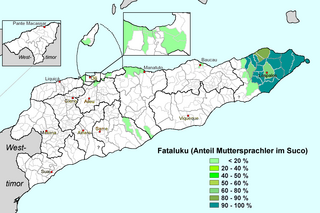Fataluku (also known as Dagaga, Dagoda', Dagada) is a Papuan language spoken by approximately 37,000 people of Fataluku ethnicity in the eastern areas of East Timor, especially around Lospalos. It is a member of the Timor-Alor-Pantar language family, which includes languages spoken both in East Timor and nearby regions of Indonesia.[2] Fataluku's closest relative is Oirata,[3] spoken on Kisar island, in the Moluccas of Indonesia.[4] Fataluku is given the status of a national language under the constitution. Speakers of Fataluku normally have a command of Tetum and/or Indonesian,[5] those speakers who are educated under Portuguese rule or from younger generation educated under Portuguese-language educational system during independence speak Portuguese.
| Fataluku | |
|---|---|
| Region | Eastern East Timor |
Native speakers | 48,000 (2020)[1] regional usage |
Trans–New Guinea ?
| |
| Official status | |
Recognised minority language in | |
| Language codes | |
| ISO 639-3 | ddg |
| Glottolog | fata1247 |
 Distribution of Fataluku in East Timor | |
It has a considerable amount of Austronesian loanwords, and it has borrowed elements of Sanskrit and Arabic vocabulary via Malay and elements of Portuguese.[3]
The five main Fataluku dialects are identified as follows: East Fataluku, South Fataluku, Central Fataluku, North Fataluku and Northwest Fataluku. [6] The differences that exist between these dialects, especially beyond phonology, are unclear and require more research. Dialects differ with respect to the phonetic realization of palatal obstruents, the presence of a glottal stop phoneme and a voicing distinction in stops, as well as aspects of the stress system. [7]
Phonology edit
Vowels edit
| Front | Central | Back | |
|---|---|---|---|
| Close | i /i/ | u /u/ | |
| Mid | e /e/ | o /o/ | |
| Open | a /a/ |
Consonants edit
| Bilabial | Labiodental | Coronal | Palatal | Velar | Glottal | ||
|---|---|---|---|---|---|---|---|
| Nasals | m /m/ | n /n/ | |||||
| Plosive | p /p/ | t /t/ | k /k/ | ' /ʔ/ | |||
| Affricates | voiceless | c /t͡s/² | c /t͡ʃ/¹ ² | ||||
| voiced | j /d͡ʒ/ | ||||||
| Fricatives | voiceless | f /f/ | s /s/ | h /h/ | |||
| voiced | v /β/² | v /v/² | z /z/ | ||||
| Flap | v /ⱱ/² | r /ɾ/ | |||||
| Lateral | l /l/ | ||||||
| Semivowel | v /w/² | y /j/ | |||||
- ¹ Spelled <tj> in Nácher orthography.
- ² Pronunciation of ⟨v⟩ and ⟨c⟩ varies in dialects.
Words and phrases edit
In the examples below, the letter 'c' and the letter combination 'tx' are pronounced as the 'ch' in the English word 'church'.
Rau ana kapare? / e nicha rau rau / maice ana umpe? "how are you?" Rau "good" Kapare "not good" Hó "yes" Xaparau "thank you" Tali even xaparau "thank you very much" nitawane "you're welcome" Favoruni "please" itu nae tini "excuse me" Ó lai'i "hello" mua toto, ia toto,purupale " take care" Kois ta niat ali fanuhene "see you later" Pronoun Possessive pronoun I : Aniri/Ana My: Ahani You : Eri (singular), Iri (plural) Your: Eheni(sing), Eheniere (plur) We : Iniri (excl), Afiri (inclusive) Our: Inihini (exc), Afihini: (incl) They : Tawari, Márafuri Their: Their Tavarhini, Marafurhini He/She : Tavai, marí, mármocoi His/Her: Tavahini, Marmokoihini It : Iví Its: Ivihini, Tavahini
See also edit
Notes edit
- ^ Fataluku at Ethnologue (25th ed., 2022)
- ^ Heston (2015), p. 3
- ^ a b Usher, Timothy. "Fataluku". newguineaworld. Archived from the original on 2020-03-05.
- ^ Heston (2015), p. 6
- ^ Heston (2015), p. 5
- ^ Van Engelenhoven, Aone. 2009. On derivational processes in Fataluku, a non-Austronesian language in East Timor. In W.L. Wetzels (ed.), The linguistics of endangered languages: Contributions to morphology and morphosyntax, 331–362. Utrecht: LOT.
- ^ Engelenhoven, Aone van & Juliette Huber. 2020. East Fataluku. In The Papuan Languages of Timor, Alor and Pantar: Volume 3, vol. 3, 347–425. De Gruyter Mouton. https://doi.org/10.1515/9781501511158.
Further reading edit
- Heston, Tyler M. and Locke, Stephanie (2019). "Fataluku". Illustrations of the IPA. Journal of the International Phonetic Association. 49 (3): 419–425. doi:10.1017/S0025100316000190
{{cite journal}}: CS1 maint: multiple names: authors list (link), with supplementary sound recordings.
References edit
- Nácher Lluesa, Alfonso María; Fidalgo Castro, Alberto; Legaspi Bouza, Efrén; Delgado Rosa, Frederico; Hull, Geoffrey Stephen (2012). Léxico Fataluco-Português (PDF) (in Portuguese). Dili: Salesianos de Dom Bosco Timor-Leste. hdl:2183/9927. ISBN 978-84-695-4633-8.
- Heston, Tyler M. (2015). The Segmental and Suprasegmental Phonology of Fataluku (PDF) (PhD thesis). University of Hawai'i at Mānoa. hdl:10125/51090. Archived from the original (PDF) on 2020-03-05. Retrieved 2019-11-25.
- Conceição Savio, Edegar da (2016). Studi Sosioliguistik Bahasa Fataluku di Lautém [Sociolinguistic study of the Fataluku language in Lautém] (Doctoral thesis) (in Indonesian). Leiden University. hdl:1887/37552.
External links edit
- Fataluku Language Project
- Fataluku language website
- Fataluku community and language with Fataluku/English and English/Fataluku wordlists Archived 2017-05-04 at the Wayback Machine
- Fataluku wordlist at the Austronesian Basic Vocabulary Database
- Materials on Fataluku are included in the open access Arthur Capell collection. (AC2) held by Paradisec.
- Songs in Fataluku are included in the Ros Dunlop collection held by Paradisec.
- The UCLA Library Modern Endangered Archives Program collection of Fataluku Language and Culture